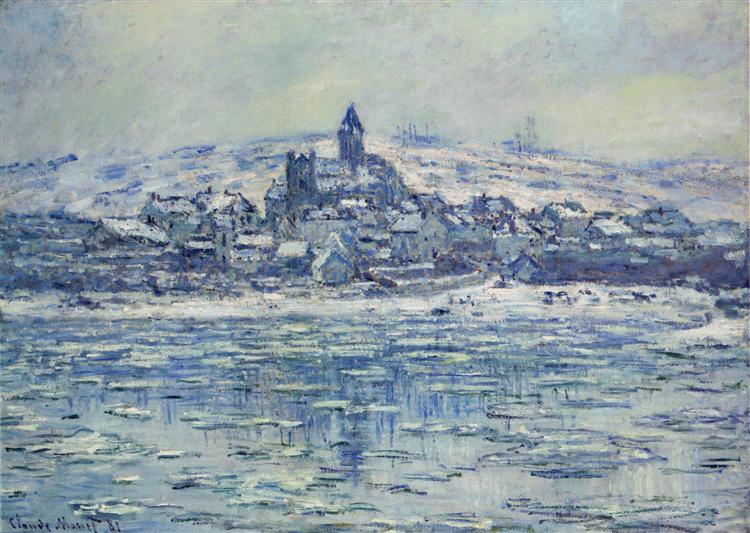Beskrivelse
Claude Monet’s painting “Vetheuil – Ice Floes”, created in 1881, stands as an eloquent testament to the Impressionist master’s skill in capturing the atmosphere and light of a particular landscape, especially in the sense of temporality and ephemerality. The work transports us to the banks of the River Seine, seen from the village of Vetheuil, where Monet had established his home and studio since 1878. This personal context, coupled with the beauty of the surroundings, becomes the backdrop for a winter depiction in which ice and water intertwine in a captivating visual game.
The composition shows a tendency towards a balance between the sky and the water's surface, both elements creating a visual dialogue thanks to the palette of cold blues combined with the luminosity of the whites and greys that represent the ice. The floating icebergs in the foreground stand out as protagonists, creating a texture that resembles the crystalline nature of frozen water. The flashes of light that are reflected on the surface of the river become ephemeral interactions of colour that reveal Monet's mastery of the technique of loose and gestural brushwork, typical of Impressionism.
Monet does not incorporate human figures in this work, which emphasizes the immensity of the natural environment versus the fragility of human existence. Through this choice, the viewer is invited to contemplate the relationship between human beings and nature, where the sublime is presented in the majesty of the landscape. The point of view from which Monet chose to paint his work is fundamental; it places the viewer in an intimacy with the landscape, as if we shared with the artist the same icy air that envelops the scene.
The choice of the subject of ice floes in this painting also reflects a common concern in the work of Monet and his contemporary Alfred Sisley, who explored the effects of light and weather on the landscape through works depicting various seasons. “Vetheuil – Ice Floes” connects to this legacy; Monet had devoted much of his career to capturing the mutability of light and color in the landscape, a principle that is especially palpable in this work.
Furthermore, this period of his career coincides with chromatic experimentation and the search for a greater capture of the ephemeral, where atmospheric conditions play a crucial role in the interpretation of the landscape. Monet experimented with different times of day and year, and in “Vetheuil - Ice Floes”, the pale tones of winter seem to fit his quest to capture the essence of time.
The use of colour in this work is also notable. Monet displays subtlety in using gradations ranging from deep blues to winter greys, passing through touches of ochre in the representation of the land and nearby vegetation. This tonal variety, together with the enveloping atmosphere created, underlines the artist's ability to capture not only a moment in time, but also the feeling evoked by the sight of a frozen landscape.
“Vetheuil - Icebergs” falls at a crucial moment in Monet’s oeuvre, where his commitment to Impressionism is reflected in his constant search to bring to life the sensations that surround him. This painting not only reveals the artist’s technical mastery, but also invites a reflection on the relationship between human beings and their environment, a theme that remains relevant in art to this day. The work is ultimately a reminder of the ephemeral beauty of nature and of Monet’s ability to capture the seemingly immutable in a moment of undeniable transformation.
KUADROS ©, a famous painting on your wall.
Hand-made oil painting reproductions, with the quality of professional artists and the distinctive seal of KUADROS ©.
Painting reproduction service with satisfaction guarantee. If you are not completely satisfied with the replica of your painting, we will refund 100% of your money.

